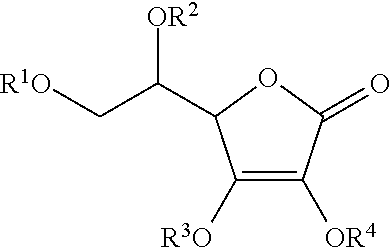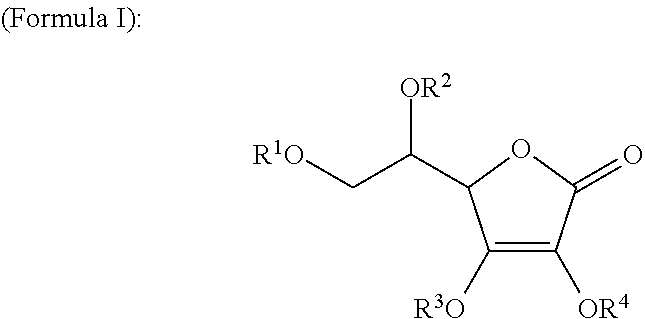Anti-plant-virus agent
a virus agent and anti-plant technology, applied in the field of anti-plant virus agents, can solve the problems of reducing the value of commodities, affecting the appearance, and production quantity of crops, and it is difficult to specifically inhibit only the proliferation of viruses, so as to suppress the onset of plant diseases, prevent the effect of plant viruses, and high anti-plant viral activity
- Summary
- Abstract
- Description
- Claims
- Application Information
AI Technical Summary
Benefits of technology
Problems solved by technology
Method used
Image
Examples
examples
[0044]Hereinafter, while the present invention will be more specifically illustrated by way of examples, the scope of the present invention should not be construed as being limited thereto.
[0045](Examples of the Ascorbic Acid Derivatives Used in the Anti-Plant Virus Agent of the Present Invention)
[0046]Examples of the ascorbic acid derivatives and the salts thereof, which have been synthesized by the esterification or glycosylation of ascorbic acid, or which are commercially available, are shown in Table 1-1 to Table 1-13. R1 to R4 in the tables correspond to R1 to R4 in Formula (I).
[0047]
TABLE 1-1R1R2R3R41SO3HHHH2PO3H2HHH3glucosylHHH4mannosylHHH5galactosylHHH6COCH3HHH7COC3H7-iHHH8COC17H35-nHHH9COC16H33-nHHH10COC18H37-nHHH11CO(CH2)7CH═CHC6H13-nHHH12COCH═CH2HHH13COCH2CH═CH2HHH14HSO3HHH15HPO3H2HH16HglucosylHH17HmannosylHH18HgalactosylHH19HCOCH3HH20HCOC3H7-iHH21HCOC17H35-nHH22HCOC16H33-nHH23HCOC18H37-nHH24HCO(CH2)7CH═CHC6H13-nHH25HCOCH═CH2HH26HCOCH2CH═CH2HH27HHSO3HH28HHPO3H2H29HHglucos...
experiment i
Comparative Example 1
[0060]Each of the frozen tobacco leaves infected with Turnip mosaic virus and Cucumber mosaic virus (Y strain) was triturated in 0.1M phosphate-buffer solution at a 10-fold amount (containing 10 mM diethyldithiocarbamic acid (DIECA)). These were defined as virus inoculation solutions A and B. These virus inoculation solutions A and B are solutions causing a 100% incidence.
[0061]Three expanded leaves per one column of Arabidopsis thaliana (Columbia) were inoculated with each virus via the aforementioned virus inoculation solutions A and B by the carborundum method.
[0062]On the 3rd day and the 1st day prior to the date of the virus inoculation, and on the 1st day, the 3rd day, the 5th day, the 8th day and the 10th days after the date of the virus inoculation, an aqueous solution of 0.1% of a spreading agent (Approach BI: manufactured by Kao Corporation) was sprayed thereon.
[0063]On the 14th day after the virus inoculation, the presence or absence of disease sympto...
example 1
[0065]Ascorbic acid 6-palmitate, a nonionic surfactant (polyoxyethylene sorbitan monolaurate) and a spreading agent (Approach BI: manufactured by Kao Corporation) were dissolved in N,N-dimethylformamide. This solution was added to water to obtain an aqueous solution of the anti-plant virus agent comprising 20 mM ascorbic acid 6-palmitate, 0.05% of a nonionic surfactant, 0.1% of a spreading agent, and 1% of N,N-dimethylformamide. Except that the aqueous solution of the anti-plant virus agent was sprayed thereon instead of the aqueous solution of ascorbic acid, in the same manner as Comparative Example 2, Turnip mosaic virus and Cucumber mosaic virus (Y strain) were inoculated onto Arabidopsis thaliana, and then the onset of symptoms was examined. Among each of the seven columns inoculated with Turnip mosaic virus and Cucumber mosaic virus (Y strain), each of five columns showed symptoms, and each of two columns were healthy.
PUM
| Property | Measurement | Unit |
|---|---|---|
| time | aaaaa | aaaaa |
| molecular-weight | aaaaa | aaaaa |
| structure | aaaaa | aaaaa |
Abstract
Description
Claims
Application Information
 Login to View More
Login to View More - R&D
- Intellectual Property
- Life Sciences
- Materials
- Tech Scout
- Unparalleled Data Quality
- Higher Quality Content
- 60% Fewer Hallucinations
Browse by: Latest US Patents, China's latest patents, Technical Efficacy Thesaurus, Application Domain, Technology Topic, Popular Technical Reports.
© 2025 PatSnap. All rights reserved.Legal|Privacy policy|Modern Slavery Act Transparency Statement|Sitemap|About US| Contact US: help@patsnap.com



